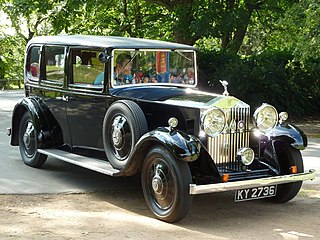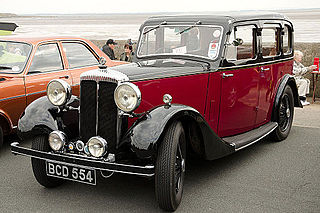
The Rolls-Royce 20/25 is the second of Rolls-Royce Limited's inter-war entry-level models. Built between 1929 and 1936, it was very popular, becoming the most successful selling inter-war Rolls-Royce. Its success enabled Rolls-Royce to survive the Great Depression, and remain one of World's great brands. 3,827 20/25s were produced, and more than 70% of these survive in use.
The Rover 8 was a small single-cylinder 8 hp 1327 cc car made by the British Rover car company. It was Rover's first production car. It was remarkable for being supported by a backbone chassis rather than a conventional ladder frame. The first model was manufactured from 1904 to 1912. A Daimler-Knight sleeve valve engine option was available on the original model in 1911 and 1912.

The Rover 6 was a small two-seater 6-horsepower car and only the second car model made by the British Rover car company. Announced in January 1905 a 6-horsepower car remained available from Rover until 1912.

The Rover 10 was a small family car from the British Rover car company produced between 1927 and 1947.

The Wolseley Hornet is a six-cylinder twelve fiscal horsepower lightweight automobile which was offered as a saloon car, coupé and open two-seater as well as the usual rolling chassis for bespoke coachwork. Produced by Wolseley Motors Limited from 1930 until 1936, the Hornet was unveiled to the public at the end of April 1930. Wolseley had been bought from the receivers by William Morris in 1927.

The Rover Meteor was a short-lived 2½-litre or 2-litre medium-sized car made by The Rover Company Limited of Meteor Works Coventry. The new 2½-litre model was announced in mid-February 1930 to supplement Rover's Light Twenty which used the same engine and essentially the same chassis.

The Sunbeam-Talbot 90 is an automobile which was produced and built by Sunbeam-Talbot from 1948 to 1954 and continued as the Sunbeam Mk III from 1954 to 1957.

The Rover Light Six was a narrower lightweight short wheelbase variant of their Two-litre sports saloon produced from 1929 to 1930 by the Rover Company of Coventry. The following season it was sold with a 2½-litre 20 hp engine under the name Rover Light Twenty.

The Rover 12 was a name given to several medium-sized family cars from the British Rover car company between 1905 and 1948.

The Vauxhall 30–98 is a car manufactured by Vauxhall at Luton, Bedfordshire from 1913 to 1927. In its day, its best-known configuration was the Vauxhall Velox standard 4-seater with open tourer body. Vauxhall's own description was the 30–98 hp Vauxhall-Velox sporting car. The 30–98 is also known to enthusiasts by Vauxhall's chassis code E.

The Vauxhall 25 h.p. chassis code D type is a car manufactured by Vauxhall from 1912 to 1922. More than 1,500 were supplied to the British Army in World War I for use as staff cars. Each Vauxhall chassis was sold with a three-year guarantee including regular inspections.
The Rover 16/50 and Rover 16 are mid-sized cars which were produced by Rover from 1926 to 1929 and non-continuously from 1936 to 1947 respectively.

The Daimler Fifteen was a saloon car at the low end of Daimler Company’s range, offered between 1932 and 1937. It was the first Daimler product for more than two decades with an engine that breathed conventionally through poppet valves. Conventional valve gear had improved, superseding the former advantages of the Daimler-Knight sleeve-valve technology. The car's name derived from its tax rating of 15 hp. The design of its 6-cylinder 1.8-litre engine was developed from the 4-cylinder 1.2-litre Lanchester Ten which was installed in Lanchester's shorter versions of the same chassis and bodies and using the same Daimler semi-automatic transmissions.

The Vauxhall 23-60 is a four or five-seater touring car manufactured by Vauxhall of Luton that was announced in July 1922. The 23-60's standard tourer Kington body was described as "preserving that greyhound look so characteristic of the Vauxhall car". It shared many parts with Vauxhall's much more powerful 30-98.

The Vauxhall 20-60 is a four or five-seater saloon, limousine, tourer or coupé-cabriolet manufactured by Vauxhall of Luton. It was announced on 28 September 1927 with a six-cylinder engine and a four-speed gearbox. A cautious move downmarket. "The first time any six-cylinder Vauxhall has been sold under £1000!" "British & Vauxhall". The initial 2.7-litre engine was enlarged to 3-litres after twelve months.

Their new Daimler 22 horsepower full-size luxury car was first displayed by Daimler in April 1902 at The Automobile Club’s Exhibition in London's Agricultural Hall. Daimler had elected to drop their multiple old low powered designs and restrict themselves to this 22 horsepower and a pair of 9 or 12 horsepower cars to the same design as the 22 but more lightly constructed. The King’s not quite finished new Daimler 22 was reported to be the chief attraction of the show.
The Rover Two-litre was a mid-size luxury open tourer, saloon or limousine produced from 1927 by the Rover Company of Coventry and available through to 1932. As usual the chassis was also available to coach builders.

Alvis Silver Crest is a 4 or 5 passenger saloon car or coupé produced by the Alvis Car and Engineering Company between 1937 and 1940. It used advanced technology intended to provide a top speed in excess of 80 miles per hour (129 km/h) and sold at a relatively high purchase price. Announced in mid-August 1937, production ended just before the war when a new-shaped body entered production.

The Lagonda 14/60 is a sports touring car that was introduced by Lagonda in 1925. Production of the 14/60 continued until 1931. As well as the standard car there were variants called the 2 Litre Speed (1927–33) and Continental.

The Vauxhall Big 6 is a name given to a series of automobiles which was produced by Vauxhall in England from 1934 to 1940. Rolling chassis were also bodied in Australia.

























